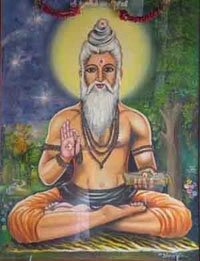A short study of Patanjali, the father of Yoga
Patanjali was a great scholar of ancient India. We still don't know his exact dates, some believe he lived before Christ and some a little after Christ. He wrote a book on grammar to discipline the speech. A second monumental work on medicine to help us to look after the body. Finally, he wrote a masterpiece to show us how to control the mind, the Yoga Sutra, in 195 short sentences or else aphorisms.
It is said that, without Patanjali Yoga would have been lost today. "If you cannot understand Patanjali, you will not understand Yoga, not with standing all the literature aivalable on Yoga". The Yoga Sutra is not a manual of Yoga practices. It deals with Yoga Philosophy and the student ; however, means and methods for all types of students, from the beginner to the ready one. So, first of all, ask your yoga teacher to tell you about Patanjali's work ! Here you will find a short explanation of the first sutra, which is an answer to the following question : what is trully Yoga and why we have to use technics ?
1.2 YOGA IS THE CONTROL OF MENTAL MODIFICATIONS
According to Samkhya philosophy, on which the Yoga Sutra is grafted, the 3 constituents of matter, that is Sattwa (purity, harmony, lucidity), Rajas (energy, passion) and Tamas (inertia and darkness), form the mind. They are responsable for the whole mental modifications or activities, negative or positive. It means, for exemple, responsable for the distractions and the limitations when Sattwa in our personality is just not enough and Tamas too much. We usually listen the dark side inside us more than the light.
They are the 3 constituents of the Ego. We feel having a clear mind and focused, full of energy on Monday, but on thursday we feel tired and depressed because of all energy used the day before and no aim can appear clearly anymore... We, all of us, have experienced this state of mind. This feelings, this instability, are the results of the mental modifications. They can become very heavy for the individual and create chronic sadness, chronic tiredness, until mental disease. Patanjali offers here to stop this infinit process, to get out from misery by a sincere Yoga practice. Yoga is therefore the control of mental modifications. Our mind becomes stronger by practicing. The various technics, step by step as a life path, are developted in the second part of the book :
1. Yama and Niyama : Yamas are restraints such as non violence (physical and mental), truthfulness (towards others and ourself), non stealing, continence, non covetousness. The Niyamas are observances such as purity (of body and mind), contentment, fortitude, self study, surrender to the highiest. As we said in the precedent note, Yoga is not about interdictions. In our life, it is enough to be and feel a good human and in this way, the Niyamas are much more important.
2. Asana : training of the body and the mind through physical and mental postures. A very methodical practice ending automatically by resting any organs, because to be healthy is a duty. Whitout a trained body, or a ready body, the yogi cannot go forward, cannot reach the following technics or steps and will experience pain in this next steps.
3. Pranayama : The regulation of bioenergy. Through breathing exercices, we achieve respiratory and nervous control, we become steady. We start to understand much better the activities inside and the link between body consciousness and mind.
4. Pratyahara : If with the other steps the physiological activities are well harmonized and under control, then, this step is to fill the gap between the body and the mind, throught psychosomatic training, by the process of abstraction. This consist of relaxation, centralisation, visualisation, dissociation, processes created to free ourself from sensual, emotional, environmental distractions. By distractions we mean everything that brings misery, that prevents from happiness.
5. Dharana and Dhyana : meditation to reach higher levels of consciousness.
6. Samadhi : Or silent state. The yogi remains unmoved by physical and mental afflictions, eternal peace.
What is to be remember here is, that every step or technic cannot be followed without each other. In that way, always keep in your mind the first virtue, the practice of the discipline of Ahimsa or non violence, whether violence is actually caused or is caused to be done by others, or permitted to be done by others, or is produced by desire or by anger, or by ignorance or even soft violence or intense type. Every kind of outside and inside violence should be avoid, at least identified and treated. The discipline of non violence is like a key that will open every door and brings the student into the following steps without much efforts, if and only if the practice of non violence becomes natural within. So be kind with the stranger and with yourself. Don't still the peace of mind of anyone, cause it's a form of violence.



/https%3A%2F%2Fassets.over-blog.com%2Ft%2Fcedistic%2Fcamera.png)
/https%3A%2F%2Fstorage.canalblog.com%2F16%2F21%2F1407383%2F114368433_o.jpg)
/https%3A%2F%2Fstorage.canalblog.com%2F98%2F39%2F1407383%2F114190769_o.jpg)
/https%3A%2F%2Fstorage.canalblog.com%2F62%2F42%2F1407383%2F114190491_o.jpg)
/https%3A%2F%2Fprofilepics.canalblog.com%2Fprofilepics%2F1%2F4%2F1403704.jpg)